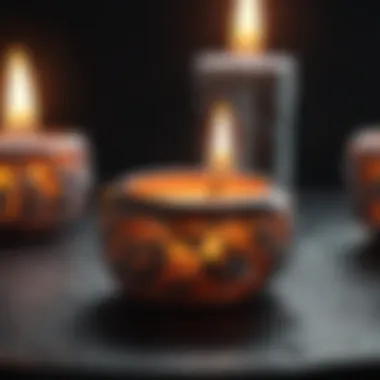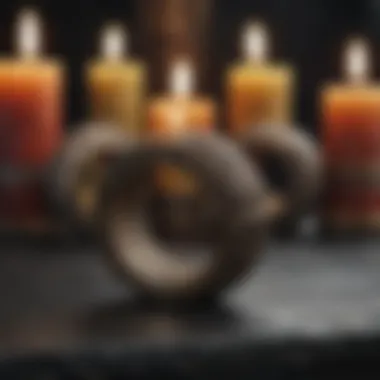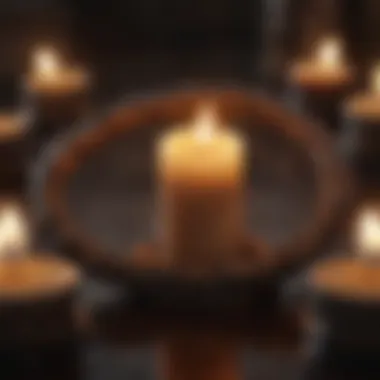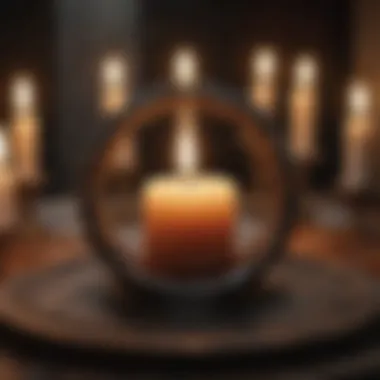The Symbolism of Fire and Ice in Game of Thrones


Intro
The complex interplay of fire and ice serves as a profound theme in the Game of Thrones narrative, intricately represented through the symbolism of candle rings. These artifacts are not mere decorative items; they encapsulate the duality of existence, reflecting the struggles and journeys of key characters. This exploration aims to provide a meticulous understanding of the diverse meanings behind these candle rings and how they connect to significant moments within the series.
Character Dissections
Detailed analysis of key characters in Game of Thrones
In the series, characters embody elements of fire and ice, illustrating their personalities and destinies. Daenerys Targaryen, often associated with fire, reflects ambition and the destructive potential of power. Her reliance on it is highlighted during pivotal moments, including her fiery dragon-related episodes. Conversely, Jon Snow, with his connections to ice—symbolized through his Stark roots—represents honor, duty, and sacrifice.
Influence of choice is crucially shown in both arcs. Each character’s decisions around these elements reshape their journey, with candle rings acting silently as observers of their fates.
Character development throughout the series
The evolution of Daenerys and Jon surfaces through their encounters and conflicts. Initially driven by stark contrasts in belief systems, fire and ice emphasize their entwined destinies by the conclusion of the series. This duality evolves engaged audiences as threads of fate bind them, showcasing how their individual growth mirrors larger thematic concerns.
Impact on the overarching storyline
Candle rings serve as physical manifestations of pivotal character arcs, acting as focal points for their fire and ice alignment. Each element ultimately influences community loyalty and ambition, propelling the storyline to its climax. Understanding these elements can deepen appreciation for how the series weaves folklore and powerful characters into its narrative fabric.
Lore Explorations
Delving into the rich history and lore of Westeros
In the lore surrounding Game of Thrones, fire and ice have existed long before the series began, separately woven into the myths of Westeros. The connection between the Targaryens and dragons emphasizes this longstanding cultural weight.
Uncovering hidden details and connections
Candle rings represent more than just symbolism; they also embody heritage. The candles burning brightly signify hope, while their icy counterparts remind characters of looming darkness.
Exploring the cultural and mythical aspects of the world
In a world alive with political intrigue and ancient hremonies, the interplay of fire and ice through candle rings maps the characters' experiences within broader historical narratives. This juxtaposition is crucial for emphasizing context, standardizing symbolism and lore profoundly encrypted within the lore of Westeros.
Fan Theories
Compilation of popular and intriguing fan theories
Fans have analyzed the fire and ice elements and theorize about the future. Many speculate that the remnants of candle rings will linger in some capacity post-series conclusion, indicating unresolved tensions ultimately linked to broader themes within the show.
Evaluation of theories based on evidence from the show
Examining fan theories provides insight into viewer perspectives on narrative elements. The polarization symbolizes loyalty divisions or conflicts entrenched in characters' motivations. This breaks down perception, offering potential futures rooted in either fire or ice.
Speculation on future plot developments
As fans engage and theorize about sequels or spin-offs, the conversation shifts toward which elements encounter resolution. Maintaining the essential essence of candle rings through plot exploration resonates the thematic growth encountered.
These involved analyses and mythical understandings unite to deepen viewer engagement, vitality awaiting each future unveiling of sequence.
In summary, candle rings signify the duality of fire and ice.


wih unique character intertwining and social constructs to various extent, the significance of these Anction resonates broader thematic concerns—unfolding systematically, shot energizing narrative fabric from inside cerebral stratas of complex visuals.
Prologue to the Themes of Fire and Ice
The symbolism of fire and ice in urban contexts speaks volumes about the complexities of human emotion and conflict. These elements do not simply exist in isolation within the world of Game of Thrones; instead, they stand for deeper narratives of struggle and resistance. Their orchestration is particularly significant when one considers candle rings, which effortlessly encapsulate themes that impact both character development and broader plotlines.
In this segment, it is crucial to explore the foundational ideas attaching fire and ice to this narrative. This inquiry aids both casual viewers and dedicated fans in grasping the fundamental misunderstandings pivotal to character choices and alliances. For instance, the polarized perspectives surrounding the elemental themes reflect on the historical conflicts postured throughout the story, constantly reminding people of the preciousness of balance.
As we delve deeper into the definitions of fire and ice, understanding these themes aids in isolating noteworthy trends while paralleling specific characters with pivotal objects like candle rings. Highlighting how society connects objects of daily life emphasizes the richness these themes offer.
Defining Fire and Ice in Westeros
In the textured landscape of Westeros, fire and ice resonate with dual meanings and implications. Fire is often accompanied by images of havoc, danger, and transcendent warmth, leading characters like Daenerys Targaryen into conflicted waters. Her journey is marked by the literal and metaphorical fire associated with her dragons. This deep description also serves aesthetic illustrations for themes of power, dominant emotions, and burning desires. Thus, her character becomes an embodiment of enthusiasm and destruction.
Contrastingly, ice symbolizes restraint, cold detachment, and chilling realities. Jon Snow emerges as a natural representation of ice, being a figure characterized by noble leadership and thoughtful reflection amid doom. Honing his abilities, he safeguards humanity from the freezing grasp of the night against supernatural threats, driving home the idea of protection embodied in cold.
With these understandings, fire and ice reveal more than mere elements; they embody ideological conflicts, power struggles, and moral introspections characteristic of the Game of Thrones narrative.
Candle Rings as a Symbol of Duality
Candle rings lend themselves as symbolic objects anchored deeply in the aesthetics surrounding fire and ice. These ornaments appear as nuanced methods to depict duality’s organic existence — encompassing the pulse of attribute and consequence without overt dramatization. In many settings, they represent the dual presence of light and darkness cloaked within surrounding hues.
The intricate craftsmanship reflects a melding of personal and historical significance. Some candles symbolize the whims of governance, while others exhibit complexities between two forces battling for supremacy. Each ring consistently merges the profound dynamics found in special scenes throughout the story. Given that the flames of connection often flicker unpredictably in the series, candle rings intimate the ever-present balance navigating these opposing ingredients of existence.
The importance extends to showcasing the omnipresence of fires and instances of frost. Fire inevitably seeks moisture, striving to flourish despite its surroundings, just as ice embodies regency—rendering survival tethered to nature’s juxtaposition. When analyzing character experiences, it becomes frustratingly beautiful how candle rings assert themselves as profound artifacts yet remain understated visual identifiers.
“In the world of Game of Thrones, the mingling of light and darkness finds head-on competion in elemental form. Candle rings weave authenticity and significance into narrative expression.”
The presence of candle rings enhances awareness about the intricate underlying messages spun tightly within strategic character applications, urging viewers to acknowledge these as reflections of deeper conflicts.
Through this engaging exploration of fire and ice, unified within candle ring symbolism, readers will uncover rich connotations and messages flourishing beneath the surface of both ordinary and extraordinary outcomes shaped by unpredictable illuminations.
Candle Rings: A Historical Perspective
Candle rings hold a significant place within the narrative of Game of Thrones. They serve not only as decorative items but also carry deeper meanings reflective of the interplay of fire and ice in the broader story. Exploring their historical roots provides insight into the cultural contexts that shape the series.
Understanding candle rings offers fans a chance to delve into the symbolism embedded in those small objects. They connect different characters, allegiances, and pivotal moments throughout the series. While they may appear as mere decorations, the craftsmanship and history behind candle rings reveal a rich narrative framework.
Origins of Candle Rings in Westeros
The origins of candle rings date back to ancient feasts and significant gatherings in Westeros. Early texts mention their use to enhance the dining experience. They symbolize hospitality and warmth while also signifying status.
Distinctive designs appear in different regions, with each incorporating unique styles influenced by local customs. For example, the candle rings from the Reach often prioritize ornate elements made of precious metals due to the region's wealth. Alternatively, simpler forms appear in the North, portraying the practicality valued by the inhabitants.
As the series unfolds, such differences play a vital role. They hint at the underlying currents between various houses and regions of Westeros. The designs echo the lifestyle and values of their creators.
Craftsmanship and Materials Used
Candle rings in Westeros are made of various materials, showcasing the creativity and skill of artisans. Typical materials include bronze, silver, or even wood, depending on the region's availability and cultural style. This distinction reflects not only the resource accessibility but also the narratives woven into these creations.
Typically marked by intricate motifs, these candle rings may also include symbols associated with specific houses or characters. Engraving process adds exclusivity and meaning to each piece. The craftsmanship suggests a high respect forboth functionality and beauty.


Notably, the materials used often illustrate the themes of fire and ice—as the flame warms the wax candle, the cold metals may fittingly symbolize resilience against harsh winters. The circular design signifies continuity and indicates the cycle of life and the enduring nature of the struggle between opposing forces.
In the fine balance between craftsmanship and meaningful design, the stories of the regions come alive.
By examining their historical roots and the craftsmanship, it is clear that candle rings play a vital role in capturing Westeros' rich cultural fabric. As the narrative unfolds, these artifacts remain crucial touchstones within the landscape of fire and ice.
The Role of Candle Rings in Game of Thrones
Candle rings hold significant importance within the Game of Thrones universe. These objects serve not only as a mere practical solution to burning candles, but they signify deeper themes intrinsic to the story. The resonance of fire and ice portrayed through the candle rings serves to bolster the narratives and enrich character development across the series. They act as tangible connections between key scenes and moments, emphasizing lessons of ambition, loyalty, and resulting conflicts within the climactic battles.
Candle Rings in Significant Scenes
In the narrative arc of Game of Thrones, candle rings appear in pivotal scenes, enhancing the storytelling. For instance, the scene where Daenerys Targaryen contemplates on her decisions at the Targaryen stronghold utilizes candle rings to reflect her internal struggles. The flickering flame represents her fiery passion and determination as she prepares for war while also emphasizing the potential destruction that follows. The ring surrounding the candle symbolizes her commitment to her lineage even as she expands her reach into hostile territories.
Beyond Daenerys, other characters confront their conflicts and dilemmas, often reflected through the imagery of candle rings. In moments of Jon Snow's emotional revelations, the stability of the candle rings contrasts with his own brutal duality of loyalty and leadership, particularly involving the North and its traditions. This thematic reinforcement bridges important character transitions, illustrating how their identities are warmed by some flames while shadowed by cold consequences.
Functionality and Decorative Aspects
Candle rings also play an essential role from a functionality and decorative standpoint. Historically, they provided practical benefits. They served to elevate candles, allowing for safer candle placement and preventing wax from spilling. Such arrangements enhanced the aesthetics of flickering lights, particularly in royal halls and gathering places.
From a decorative perspective, these candle rings possessed designs that invested them with considerable symbolic representation. Crafted from various materials like wood, metal, or stone, they showcased the artistry and skill of artisans in Westeros. The intricate designs often mirrored family sigils or notable events within the narrative, linking tangible objects back to their historical context.
In essence, candle rings in the Game of Thrones universe embody much more than mere accessories for illumination. Their significance extends to encapsulating the dynamics of character interactions and their overarching relations to the enduring themes of power and ambition. Through both functionality and deeply embedded symbolism, candle rings bridge the connection between mundane objects and the epic tale of fire and ice that defines Westeros.
Character Associations with Fire and Ice
The connections between characters and the elements of fire and ice carry significant weight within the narrative framework of Game of Thrones. Daenerys Targaryen and Jon Snow embody the essence of their respective elements, exhibiting traits and arcs that reflect deeper themes of power, responsibility, and conflict. By examining how these characters symbolize fire and ice, one can glean insight into the broader conflicts within the series. Their struggles with identity and leadership illustrate not only personal battles but also the greater philosophical clash between these elemental forces.
Daenerys Targaryen: The Firebringer
Daenerys Targaryen represents fire in numerous ways throughout the series. Known as the Mother of Dragons, she uses fire in both a literal and metaphorical sense. Her fiery demeanor aligns with her fierce ambition to reclaim the Iron Throne. Daenerys’s journey from a timid girl to a formidable leader encapsulates the transformative aspect of fire.
Her ability to conjure flames stems from deep cultural roots. Targaryens are historically associated with fire, not only in their use of dragons but also in their connections to legends and lore. The famed House Targaryen motto, “Fire and Blood,” further cements this association.
Moreover, Daenerys showcases the destructive nature of fire. Her decisions often lead to devastating consequences, raising questions about morality and power. In this context, fire symbolizes both freedom and danger, encapsulating her internal conflict and the lives she touches. Thus, her character adds a complex layer to the theme of fire in Game of Thrones.
Jon Snow: The Ice Element
In contrast, Jon Snow embodies the motif of ice. His Stark ancestry roots him in the themes of coldness and restraint, culminating in battles both internal and external. While he initially assumes the role of a protector and loyal participant, his connection to the Night Watch deepens the narrative of ice surrounding his character.
Jon represents resilience in the face of adversity. Like ice forged over millennia, his character develops through trials, emphasizing loyalty and sacrifice. Moreover, his ties to mysterious northern forces amplify the ice symbolism, particularly through the omnipresent threat of the White Walkers.
His fraught relationships amplify his internal struggle. Jon is bound by duty yet yearns for personal fulfillment, mirroring the duality present in his character. Ice, representing endurance, captures Jon's internal emotional landscape—one marked by loyalty and loss.
The Balance of Power: Fire and Ice in Leadership
The duality of fire and ice directly influences leadership within the Game of Thrones narrative. Both Daenerys and Jon possess unique qualities tied to their elemental themes that inform their approaches to governance. First and foremost, fire symbolizes passion, urgency, and often chaos—qualities reflected in Daenerys’s authoritarian methods and her single-minded determination to rule.
Conversely, ice embodies restraint, honor, and often indecisiveness, as observed in Jon Snow’s struggles. His complex ethical stances sometimes conflict with effective leadership. This creates a dichotomy that is central to the series: the interplay between authoritarian rule versus principled governance.
Understanding this balance helps unravel characters' motivations. Daenerys’s fire often imparts a necessary momentum for change, while Jon’s ice offers moments of reflection. This tension leads to significant events and outcomes, positioning both characters as icons representing broader themes within Game of Thrones' world.


The interplay of fire and ice serves as a premise for all the conflict present in the series.
As we analyze these character associations, it becomes clear how deeply embedded fire and ice are in the essence of Game of Thrones, shaping narratives while anchoring viewer connections to underlying themes.
Thematic Implications of Candle Rings
The thematic implications of candle rings unveil the deeper significance behind their symbolic representation of fire and ice in the Game of Thrones universe. Understanding these implications allows us to grasp the nuances of character narratives, conflicts, and alliances that define the series. Candle rings serve not just as decorative items; they are ripe with meaning that intersects with major themes in the story. The discussion of these aspects enriches the viewers' comprehension of how this simple object is interwoven into the complex tapestry of Westeros.
Fire and Ice as Metaphors for Conflict
In Game of Thrones, fire and ice symbolize the perpetual struggle between opposing forces. Fire represents passion, desire, and instinct while ice embodies stoicism, reason, and responsibility. The Great War between the living and the dead posits this duality starkly: Daenerys Targaryen, often associated with fire due to her dragons, embodies ambition and the wrathful quest for power. In contrast, Jon Snow, linked to ice through his Northern essence, signifies honor and the fight against impending doom.
Candle rings appear in crucial moments that emphasize this dichotomy. The flames that burn within their confines bear witness to fierce battles and heated ambitions, while their encircling forms often echo feelings of entrapment and yearning for peace amid chaos. This juxtaposition feeds directly into the larger narrative conflict—with each character and faction representing various elements of fire and ice, their decisions shape the fate of Westeros.
"The intricacies of candle rings encapsulate the perpetual cycle of hope and despair in Game of Thrones."
Unity and Division: The Symbolism of Candle Rings
Candle rings symbolize both unity and division, intertwining the destinies of characters throughout the story. Their round shape signifies completeness, representing the wholeness derived from alliances. Conversely, the contrasting elements of fire and ice highlight divisions based on ideology and strength.
In community gatherings, candle rings create a spatial buffer, establishing a sense of shared purpose. They enhance the atmosphere around them during significant gatherings, be it a Westerosi council or a reunion between estranged kin. Here, the flames flickering within the rings amplify emotions, reflecting both warmth and the volatility of the situations.
Throughout the series, different families utilize candle rings to communicate their unique position in the struggle between fire and ice.
- The Starks often wield ice symbols in their household representations, linking their lineage to honor and resilience.
- The Targaryens utilize flames not only through Daenerys and her dragons but also through the connotations of destruction and rebirth that fire brings.
As such, candle rings showcase the delicate balance between harmony and discord that defines relationships in Game of Thrones. Their presence elevates character interactions, strengthening connections while highlighting the longstanding divisions that often seem insurmountable literature from en.wikipedia.org reveals much of this framework.
Fan Theories and Interpretations
Fan theories play a crucial role in deepening the understanding of Game of Thrones and its intricate themes. The discussions surrounding candle rings specifically reveal how fans engage with the material. The alignments of different characters with elements of fire and ice inhabit multiple readings. Candles themselves have their own symbolism, suggesting transformation and permanence. Recognizing these facets enables both casual viewers and devoted readers to glean fresh insights from the story.
Exploring Community Perspectives
Community discussions frequently offer new angles on the main theme of fire and ice accomplished through candle rings. Some fans interpret candle rings as symbolic of division and unity. These symbols suggest that dark times lie ahead and reflect emotional struggles faced by key players, like Daenerys Targaryen and Jon Snow.
Additionally, users across platforms such as Reddit have proposed that candle rings act as a visual foreshadowing device within the narrative. Some highlight a cherished scene from season one where candle rings bloomed as a visualization of growing tensions between enigmatic forces. The communal experience allows for richer participation in narrative construction. Often, perspectives shared in forums also generate debates on character arcs and future direction of the series.
Speculation on Future Developments
Speculating about the future of candle rings and how they might continue to evolve in Game of Thrones lore has proven popular among fans. Many anticipate that candle rings will reveal new insights into character development and unforeseen plot twists. Characteristics associated with fire, including wrath and ambition, may juxtapose rhythms suggested by ice, evoking introspection and resolve.
It’s critical to note that such discussions not only keep the fandom engaged but also allow fans to devise possible resolutions. Envisioning potential outcomes can lead to thoughtful discussions about leadership styles and their effects. For example, candle rings' dual symbolism may illustrate how collaborations between fire and ice in leadership are more essential than originally thought. Ultimately, this ongoing dialogue defines the fan experience while deepening appreciation for complex interrelationships present in the storyline.
"Fan theories transform the act of watching into an active participation in storybuilding."
These various interpretations create a richer landscape for analysis, expanding upon themes set by George R.R. Martin and portrayed in the on-screen adaptation. As candle rings continue to stir imagination, they offer fertile ground for speculation, debate, and insight into future story arcs.
Closure: The Lasting Impact of Fire and Ice Symbolism
The rich themes of fire and ice in Game of Thrones extend beyond mere character associations. They manifest as central elements that shape the series' narrative structure. The candle rings act as a pivotal metaphoric representation of these elements, linking characters and events dynamically and visually. Exploring this symbolism allows for a deeper understanding of the tensions and resolutions that underpin the factions within Westeros.
Legacy of Candle Rings in the Folklore of Westeros
Candle rings carry with them stories steeped in the rich lore of Westeros. Historically, these items are not just decorative. They embody complex cultural meanings and serve as points of connection among various houses and their histories. Each ring reflects specific traits associated with either fire or ice, symbolizing loyalty, purpose, and destiny more broadly. As symbols, they have evolved over various narratives to become totems of power and allegiances.
Famed legends emphasize the dichotomy of fire and ice as they relate to coveted artifacts. For instance, candle rings serve a recurring role during pivotal dialogues or conflicts. Where each candle ring glitters with its own history, they evoke loyalty versus ambition, destruction versus sovereignty. These juxtapositions reflect, in many stories, enduring questions about identity and fate.
Themes of sacrifice and fortitude also emerge intricately woven into the legacy of candle rings. Characters who wear these rings often confront their contrasting quests. Daenerys' fire emblem stands not just for chaos but embodies potential liberations. In juxtaposition, Jon Snow’s fate tied to ice gripes with historical burdens and shattered honor. “In the loom of conflict, candle rings illuminate the fractured path of fate.



